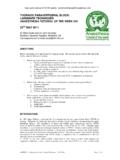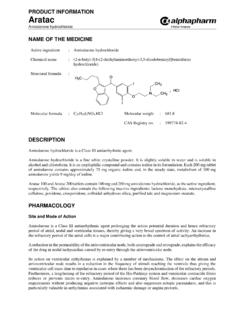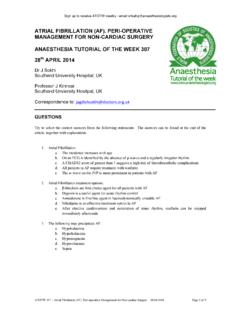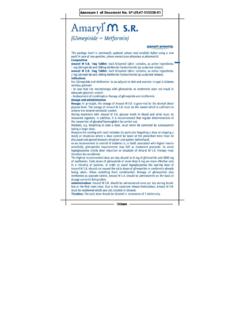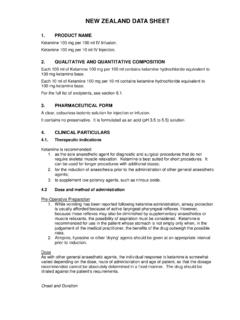Transcription of 151 Phaeochromocytoma, perioperative …
1 Sign up to receive ATOTW weekly - email ATOTW 151 phaeochromocytoma : perioperative management , 14/09/2009 Page 1 of 10 phaeochromocytoma : perioperative management ANAESTHESIA TUTORIAL OF THE WEEK 151 14TH SEPTEMBER 2009 Prabodh Sasidharan, SpR, Aberdeen Royal Infirmary Ian Johnston, Consultant, Raigmore Hospital, Inverness Correspondence to SELF ASSESSMENT 1. Regarding adrenal glands a. The medulla secretes adrenaline , noradrenaline and dopamine b. The rate limiting enzyme of catecholamine synthetic pathway is tyrosine hydroxylase c.
2 The adrenaline:noradrenaline ratio in a normal adrenal gland is 15:85 d. 2 receptors mediate the presynaptic feed back inhibition of NA release 2. Regarding phaeochromocytomas a. Phaeochromocytomas account for 1% of all cases of hypertension in adults b. MEN 2a constitutes medullary carcinoma of thyroid, hyperparathyroidism and phaeochromocytoma c. The right adrenal gland is more involved that the left d. The most common sites of extra adrenal phaeochromocytomas are the neck and thorax 3. With regards to phaeochromocytoma a.
3 Hypertension is the most common sign b. The most common symptom is sweating c. It is more common in males d. The perioperative mortality of elective phaeochromocytoma is around 2% 4. With regards to the diagnosis of phaeochromocytoma a. A total catecholamine plasma concentration greater than 2000pg/ml is diagnostic b. MIGB scintigraphy is used for locating extra adrenal tumours c. Plasma free metanephrines are the most sensitive test d. Adrenaline secreting tumours are the most common 5. With regards to the management of phaeochromocytoma a.
4 The use of ephedrine is contraindicated b. Suxamethonium induced fasciculation can set off a hypertensive crises c. Tachycardia is a side effect of prazosin d. Phenoxybenzamine is a non selective irreversible blocker Sign up to receive ATOTW weekly - email ATOTW 151 phaeochromocytoma : perioperative management , 14/09/2009 Page 2 of 10 6. Regarding phaeochromocytoma a. Hormone secretion is under neurogenic control b. Familial phaeochromocytoma is inherited in an autosomal recessive manner c.
5 Persistent hypotension after tumour removal can be due to persistent blockade and down regulation of receptors d. The perioperative mortality of untreated phaeochromocytoma can be as much as 50% INTRODUCTION Phaeochromocytomas are catecholamine secreting neuroendocrine tumours that arise from the chromaffin cells of the sympathoadrenal system. They are usually found in the adrenal gland but extra-adrenal phaeochromocytomas, though less common, are tumours that originate in the ganglia of the sympathetic nervous system.
6 It is a rare tumour, being responsible for less than of all cases of hypertension. These tumours although rare are important as they present a great challenge to the anaesthetist. The condition is potentially life threatening unless diagnosed and treated. The morbidity and mortality in an unexpected emergency situation is quoted to be 50% but less than 2% in planned surgery. Clear understanding of the pathophysiology is important to manage the condition safely. PATHOLOGY The word phaeochromocytoma in Greek means dusky coloured tumour referring to the colour it acquires when stained with chromium salts.
7 phaeochromocytoma is often referred to as the 10% tumour because 10% are extra adrenal, 10 % are malignant, 10% are inherited as an autosomal dominant trait and 10% present bilaterally. Though usually found in the adrenal medulla these tumours can be found anywhere in association with the sympathetic ganglia. The organ of Zuckerkandl near the aortic bifurcation is the most common extra adrenal site. Phaechromocytomas are usually solid highly vascular tumours.
8 Malignant spread can occur in 10% cases, with a predisposition for the liver. Ten percent of phaeochromocytomas are inherited as an autosomal dominant trait. Familial phaeochromocytomas can be part of the multiple endocrine neoplastic syndromes (MEN) and can also occur in association with neuroectodermal dysplasia. Patients with MEN2a (Sipples s syndrome) have phaeochromocytoma , medullary carcinoma of the thyroid and hyperparathyroidism.
9 Almost 100% of patients with MEN2a have or will develop phaeochromocytoma and they are frequently bilateral. MEN2b is characterised by medullary carcinoma thyroid, phaeochromocytoma and a specific phenotype consisting of a marfanoid body habitus, mucosal neuromas and intestinal ganglioneuromas. The neuroectodermal dysplasias associated with phaeochromocytomas are Von Hippel-Lindau Syndrome and Von Recklinghausen s Disease. Phaeochromocytomas are highly active tumours secreting adrenaline, noradrenaline and rarely dopamine.
10 Most tumours predominantly secrete noradrenaline. (Normal adrenal secretion is 85% adrenaline). Familial phaeochromocytomas are an exception because they secrete large amounts of adrenaline. Phaeochromocytomas are not under neurogenic control but the trigger for catecholamine release is not clear although postulated mechanisms include changes in pressure or tumour blood flow. On rare occasions chromaffinomas can secrete intestinal peptides such as VIP and somatostatins.



